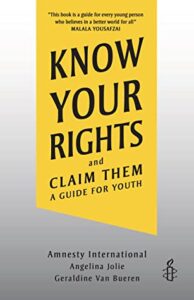Know Your Rights (And Claim Them)
Amnesty International, Angeline Jolie, with Geraldine Van Beuren
Andersen Press
Published September 2, 2021
Amazon | Bookshop | Goodreads
About Know Your Rights (And Claim Them)
Jointly written by Angelina Jolie and Amnesty International with Geraldine Van Bueren QC.
If you are aged under 18 you have your own set of human rights. Child rights are unique freedoms and protections designed for you. Governments should uphold them but all across the world they are violated. Know Your Rights (And Claim Them) gives you the knowledge and tools to claim your rights. It introduces them and explains why they matter in the real world. From gender and racial equality, to the rights to free expression, health, a clean climate and a sustainable environment, they are yours to claim.
Know Your Rights (And Claim Them) celebrates the difference young activists have made in every corner of the world, and shows you how to challenge injustice wherever you may find it. It presents expert advice on peaceful protest, raising awareness at school and in your community, starting your own campaign and getting those in power to listen, plus vital guidance on protecting your safety, digital security and mental health.
These are your rights. It is your right to know and claim them.
My Review
Probably the most important thing to note here that isn’t specified in the cover copy is that this book explains children’s rights as outlined in the United Nations Convention on the Rights of the Child (CRC). While the US has signed agreement to the convention, it has never been ratified, which means it’s not actually the law in the United States. Some of the rights outlined in the book are covered by other laws, and some protections vary based on the state in which you live.
Basically, all that is to say that the book explores the rights outlined in the UN CRC, not the rights guaranteed to a child under US law, which I didn’t realize until reading the book.
I thought it was interesting to look at what 196 nations have agreed are the legal rights all children should have. Most were pretty basic things, like the right to live in a safe place or the right to an education. Some rights protect marginalized groups, like the right to speak a native language and practice your religion (with parental guidance).
There wasn’t anything in the book that made me think, well, that’s why the convention wasn’t ratified in the US. I didn’t see anything that I found to be at odds with US values, so that was interesting.
The book has a long section about what to do if you feel that your rights are being infringed upon or if you experience injustice and want your political leaders to address it. I liked the way that section broke down what to do and how to evaluate what kinds of actions you could or should take.
Conclusion
I’ve read books aimed at this age group that were more engaging in their tone and through the inclusion of graphics and other interactive materials. I think this book gives a good overview of what rights children have under the UN CRC. It also offers a great step-by-step tool to help kids challenge groups that infringe on their rights.
Content Notes
Recommended for Ages 12 up.
Representation
The text includes brief biographies of child activists from across the world.
Profanity/Crude Language Content
None.
Romance/Sexual Content
None.
Spiritual Content
References to groups persecuted for their faith.
Violent Content
References to countries which imprison people or execute them for protesting or speaking out against the government.
Drug Content
None.
Note: This post contains affiliate links, which do not cost you anything to use, but which help support this blog. I received a free copy of KNOW YOUR RIGHTS (AND CLAIM THEM) in exchange for my honest review.
